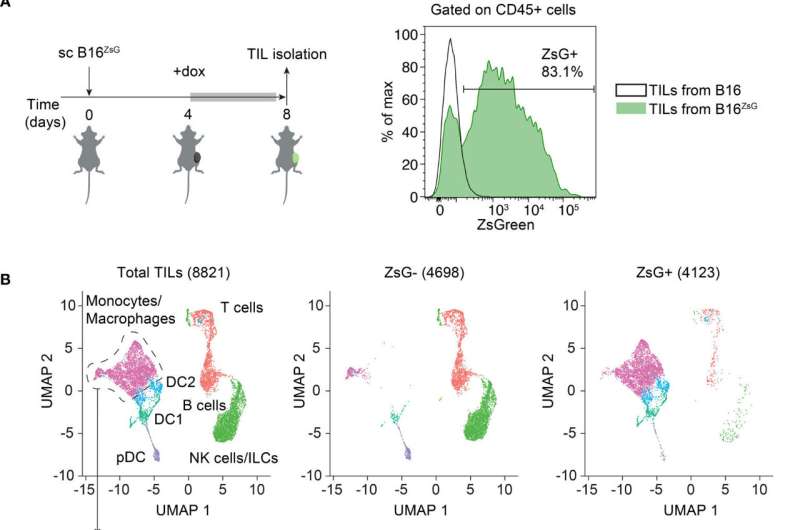This article has been reviewed according to Science X's editorial process and policies. Editors have highlighted the following attributes while ensuring the content's credibility:
fact-checked
peer-reviewed publication
trusted source
proofread
The 'mosquito effect': How tumor cells outwit the body's immune system

In a first-of-its-kind research breakthrough, a team of scientists at the University of Massachusetts Amherst has analyzed and described what they call the "mosquito effect," which sheds light on how specific pathogens, such as cancerous tumor cells, can outwit the body's immune system.
Just as mosquitoes ingest their host's blood, the immune system's T cells incorporate cytoplasmic material from tumors into their own cytoplasm. While it has long been known that many kinds of cells can transfer cellular material from one to another, cytoplasm transfer has never been observed in T cells.
Subsequent single-cell RNA (scRNA) sequencing shows that cytoplasm from tumor cells alters the machinery responsible for protein coding in the host T cell. The research, reported recently in the journal Frontiers in Immunology, is a major step forward in understanding how tumors can successfully evade the immune system, and thus a step toward more effective treatments.
One of the great mysteries in medicine is how certain pathogens can suppress the immune system in order to spread wildly. There are many different parts to the immune system, but among the most important are T cells, which identify and attack pathogens, and the T regulatory cells, which tell the T cells when it's safe to call off the attack, limiting collateral damage to the body.
And yet, cancerous tumor cells have figured out how to short-circuit the immune system, with often catastrophic results for healthy tissues. How, exactly, tumor cells do this is unknown, but, says Leonid Pobezinsky, associate professor of veterinary and animal sciences at UMass Amherst and the paper's senior author, "we've observed for the very first time that T cells and T regulatory cells suck up a bit of tumor cytoplasm and integrate it into their own."
To make the discovery, Pobezinsky and his team, including first author Kaito Hioki, a graduate student in veterinary and animal science at UMass Amherst, and Elena Pobezinskaya, research assistant professor also in veterinary and animal sciences at UMass and co-senior author of the paper, engineered tumor cells to produce an ultrabright fluorescent protein called ZsGreen.
They then introduced the green-glowing tumor cells into a mouse model. After eight days, the model's tumor-infiltrating immune cells were gathered and analyzed using state-of-the-art equipment in the Flow Cytometry lab at UMass Amherst's Institute for Applied Life Sciences.
"What we saw was striking," says Pobezinskaya. "The T cells were glowing and uniform green, which tells us that that the tumor's cytoplasm had been distributed widely throughout the T cell."
Even more surprising was to see the T regulatory cells also light up. The team found that the cells glowing the brightest were the ones most exhausted from their fight against the tumor. Finally, the team determined that the transference of cellular material requires the cells of the tumor and the immune system to come into physical contact with each other.
"We know that tumor cells use multiple ways to suppress the immune system," says Hioki. "We also now know that T cells incorporate some of the tumor in their own cytoplasm and that the least aggressive immune cells have the most tumor cytoplasm in them. What we don't know is why. Are the T cells looking for food? Are they trying to survey and adapt to their new environment by taking in parts of other cells? And finally, is the tumor hijacking this mechanism to shut down T cells?" These questions are all next steps for the authors.
More information: Kaito A. Hioki et al, The mosquito effect: regulatory and effector T cells acquire cytoplasmic material from tumor cells through intercellular transfer, Frontiers in Immunology (2023). DOI: 10.3389/fimmu.2023.1272918



















